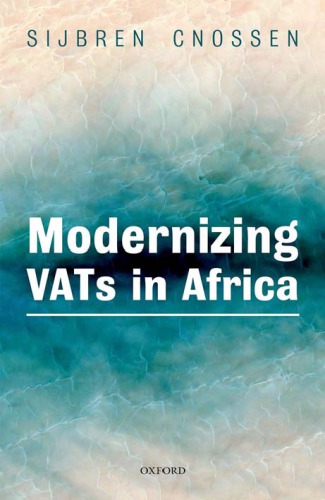Modernizing VATs in Africa 1st edition by Sijbren Cnossen 0192582379 9780192582379
$50.00 Original price was: $50.00.$25.00Current price is: $25.00.
Modernizing VATs in Africa 1st edition by Sijbren Cnossen – Ebook PDF Instant Download/DeliveryISBN: 0192582379, 9780192582379
Full download Modernizing VATs in Africa 1st edition after payment.

Product details:
ISBN-10 : 0192582379
ISBN-13 : 9780192582379
Author: Sijbren Cnossen
Most African countries are in dire need of more tax revenue. In 28 out of 45 countries with a value-added tax (VAT), total tax revenue as a percentage of GDP is around 15% or less, falling short of what is necessary to finance basic human and economic development. Far from being revenue-raising instruments, current African VATs are riddled with exemptions, exclusions, and zero rates on domestic goods and services that depress revenue, are highly distortionary, and greatly complicate the administration of VAT. Modernizing VATs in Africa enables policymakers, professionals, and students to analyse African tax systems to ascertain how they can be modernized. It explains the case for VAT base-broadening over rate-increasing, arguing that exemptions and zero rates mainly accrue benefits for higher-income groups. Even more persuasively, it demonstrates that the net result of fiscal systems can be equalizing if the revenue of broad-based VATs is used to finance in-kind transfers, such as healthcare and education. VAT modernization should be used to enable governments to finance development; Modernizing VATs in Africa puts a compelling case forward for how and why this can be achieved.
Modernizing VATs in Africa 1st Table of contents:
1. Why VAT?
1.1 Introduction
1.2 VAT’s Role in Africa’s Tax Systems
1.3 Major VAT Policy Issues
1.4 Organization of this Book
1.5 Acknowledgements
2. What is VAT?
2.1 Workings of the VAT
2.2 VAT and the P&L Account
2.3 Legal Features of the VAT
2.4 Economic Nature of the VAT
2.5 What is a Best-Practice VAT?
2.6 VAT versus Excise Taxes and Import Duties
3. Other Broad-Based Consumption Taxes
3.1 How Can Consumption Be Taxed?
3.2 Accounting for Consumption Taxes
3.3 Differences between Consumption Taxes
3.4 Preferred Choice: VAT or RST?
3.5 Prevalence of Consumption Taxes
3.6 Lessons from Worldwide Experience with VAT
4. Overview of VATs in Africa
4.1 Regional Economic Communities
4.2 Broad Characteristics of VATs
4.3 Issues to Be Explored
5. Countries without VAT
5.1 Overview of Sales Taxes in Non-VAT Countries
5.2 Distortions
5.3 Valuation Problems
5.4 Definitional Issues
5.5 Move to Wholesale Stage Not a Solution
5.6 VAT Preferred
6. Revenue Performance
6.1 Overall Revenue Performance
6.2 VAT Collection Efficiency
6.3 Understanding VAT Performance
6.4 Can VATs Replace Trade Taxes?
7. VAT Incidence and Rate Structure
7.1 The VAT Treatment of Foodstuffs
7.2 VAT Burden Distribution in South Africa
7.3 Findings for Other Countries
7.4 Zero Rate, Lower Rate, or Exemption?
7.5 Higher Taxes on Luxury Goods
7.6 Are Excise Taxes on Luxury Goods Justified?
7.7 Evaluation of Rate and Base Differentiation
7.8 The Heart of the Matter
8. Economic Integration and Tax Coordination in Regional Economic Communities
8.1 Stages of Economic Integration and Tax Coordination
8.2 Economic Policy Coordination
8.3 Tax Coordination
8.4 Creating Common Markets with Tax Diversity
9. Exemptions and ExclusionsThe Achilles Heel of VAT
9.1 Kinds of Exemptions and Exclusions
9.2 Economic Distortions and Administrative Complications
9.3 Dealing with Exemptions and Exclusions: An Overview
10. Non-Standard Exemptions and Zero Rates
10.1 Consumer Items
10.2 Producer Goods
10.3 Services
10.4 African Countries that have Led the Way in VAT Modernization
11. Governments and Activities in the Public Interest
11.1 Nature of Supplies by Public Bodies
11.2 EU-African Legacy
11.3 African Situation
11.4 Refund Systems in Europe and Canada
11.5 Full Taxation in New Zealand and Australia
11.6 What is Best Practice for African Countries?
12. Immovable Property
12.1 How Should Immovable Property be Taxed?
12.2 Exemption Method versus Tax Method
12.3 Taxation of Immovable Property in Africa
12.4 Directions for Reform
12.5 Recapitulation of Policy Proposals
13. Financial Services
13.1 VAT’s ‘Last Frontier’
13.2 Categories of Financial Services
13.3 How Are Financial Services Taxed in African Countries?
13.4 Difficulties in Taxing Financial Services under the VAT
13.5 The EU’s Exemption Approach
13.6 Taxing What Can Be Taxed
13.7 Mitigating Cascading Effects
13.8 Accounts-Based Methods of Taxing Value Added
13.9 Out-of-the-Box Approaches: Cash-Flow Method and Modified Reverse-Charging
13.10 What to Do?
14. Insurance
14.1 Insurance and the EU’s Common Directive
14.2 How Is Insurance Taxed in African Countries?
14.3 Application of VAT to Insurance
14.4 Life and Health Insurance
14.5 Comparative Evaluation
15. Lotteries and Gambling
15.1 Introduction
15.2 Types of Lotteries and Gambling Activities
15.3 Lotteries
15.4 Casinos: Slot Machines and Table Games
15.5 Some Answers
16. Small Businesses and Farmers
16.1 Small Businesses
16.2 Farmers
16.3 A Generous Threshold
17. Basic Administrative Processes
17.1 Registration
17.2 Filing
17.3 Payment
17.4 Enforcement
17.5 Audit
17.6 Fraud
17.7 Balancing Enforcement and Assisting Taxpayers
18. Agenda for VAT Modernization
18.1 Need for VAT Base-Broadening
18.2 Abolishing Non-Standard Exemptions and Exclusions
18.3 Reviewing Standard Exemptions and Exclusions
18.4 The Reason for Modernization
People also search for Modernizing VATs in Africa 1st:
the modern vat
byzantium and africa
examples of modernization in africa
how modernized is africa
modernism in africa
Tags: Modernizing VATs, Africa, Sijbren Cnossen, exemptions
You may also like…
Uncategorized
Politics & Philosophy - Government & Politics
Perspectives on Political Communication in Africa 1st Edition Bruce Mutsvairo
Politics & Philosophy - Others
Politics & Philosophy - Social Sciences
Reference - Writing
Politics & Philosophy - Politics
Social Movements and Digital Activism in Africa 2023rd Edition Ufuoma Akpojivi
Biology and other natural sciences - Plants: Agriculture and Forestry
Vermicomposting for Sustainable Food Systems in Africa 1st Edition
Business & Economics - Responsibility and Business Ethics
Resource Conflict and Environmental Relations in Africa 1st ed. 2023 Edition Kelechi Johnmary Ani












